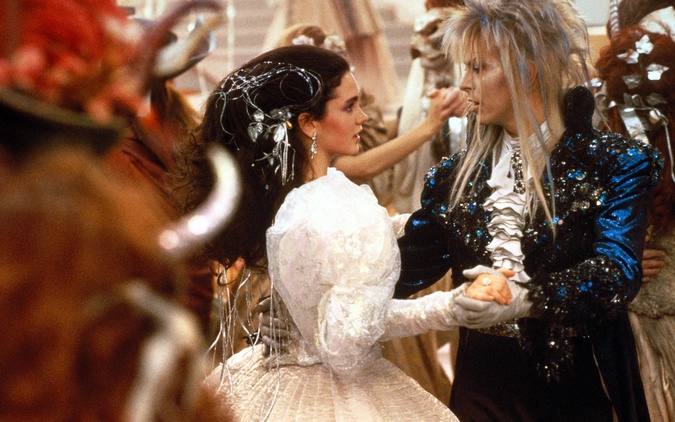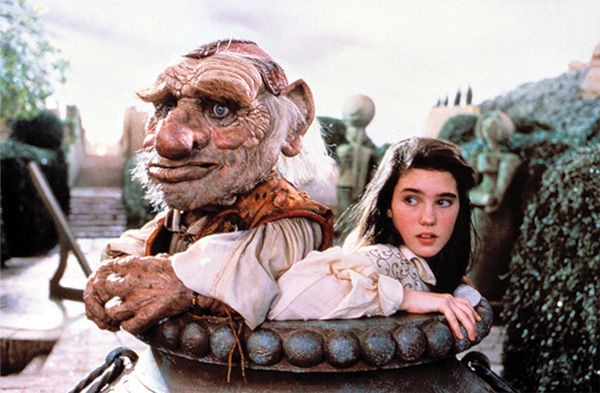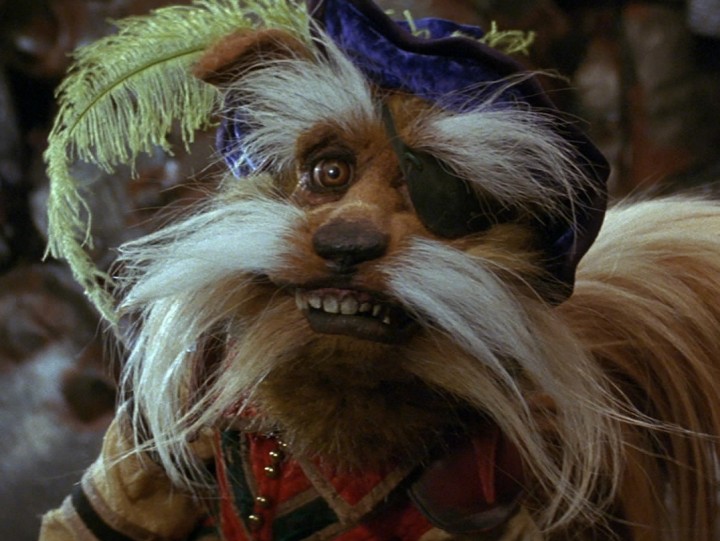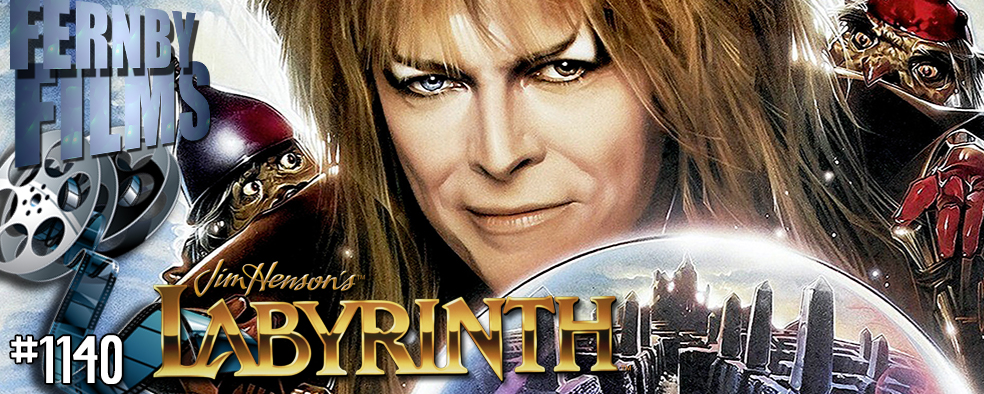Movie Review – Labyrinth
– Summary –
Director : Jim Henson
Year Of Release : 1986
Principal Cast : Jennifer Connelly, David Bowie, Toby Froud, Brian Henson, Ron Mueck, David Shaughnessy, Percy Edwards, Timothy Bateson, Michael Hordern, Denise Bryer, Danny John-Jules, Kevin Clash, David Healy, Toby Froud, Christopher Malcolm, Shelley Thompson, Natalie Finland.
Approx Running Time : 102 Minutes
Synopsis: A selfish 16-year old girl is given 13 hours to solve a labyrinth and rescue her baby brother when her wish for him to be taken away is granted by the Goblin King.
*********
You remind me of the babe.
Tapping directly into a generational touchstone is Jim Henson’s fantasy fairy-story allegory, Labyrinth, which features and early role for future Oscar-winner Jennifer Connelly, as well as musical legend David Bowie, as the eponymous villain of the film, the Goblin King. As with his previous live-action fantasy, The Dark Crystal, Henson’s venture into using puppets in a more adult manner than he’d achieved with his Muppet movies remains profoundly visually dynamic, a tour-de-force of puppetry and artistic wizardry that, sadly, is comparatively lacking in today’s computer-enhanced cinema.
 When she’s forced to stay home and babysit her stepbrother Toby (Toby Froud), young Sarah Williams (Connelly) goes all Candyman on his ass and whispers that she’s love the Goblin King (David Bowie) to whisk him away to his castle so she could be rid of him. Naturally, the Goblin King arrives, and whisks Toby away, much to Sarah’s instant regret. As a challenge, the Goblin King sets Sarah a mission – unravel the enormous labyrinth surrounding his castle within 13 hours, and he’ll return Toby to her. Sarah, as she embarks on her desperate quest, soon encounters a variety of creatures within the labyrinth, some of whom are a help, and others, a hindrance. Chiefly, Hoggle (voice of Brian Henson), a dwarf who is secretly in the Goblin King’s employ, as well as Ludo (Ron Mueck) and the tiny fox Sir Didymus (David Shaughnessy), as well as Sir Didymus’ faithful steed, the old English sheepdog named Ambrosious. Together, they make their way to the Goblin City, battling obstacles and traps until, eventually, they stand at the gates of the Goblin King’s castle.
When she’s forced to stay home and babysit her stepbrother Toby (Toby Froud), young Sarah Williams (Connelly) goes all Candyman on his ass and whispers that she’s love the Goblin King (David Bowie) to whisk him away to his castle so she could be rid of him. Naturally, the Goblin King arrives, and whisks Toby away, much to Sarah’s instant regret. As a challenge, the Goblin King sets Sarah a mission – unravel the enormous labyrinth surrounding his castle within 13 hours, and he’ll return Toby to her. Sarah, as she embarks on her desperate quest, soon encounters a variety of creatures within the labyrinth, some of whom are a help, and others, a hindrance. Chiefly, Hoggle (voice of Brian Henson), a dwarf who is secretly in the Goblin King’s employ, as well as Ludo (Ron Mueck) and the tiny fox Sir Didymus (David Shaughnessy), as well as Sir Didymus’ faithful steed, the old English sheepdog named Ambrosious. Together, they make their way to the Goblin City, battling obstacles and traps until, eventually, they stand at the gates of the Goblin King’s castle.
As a kid, this film both terrified and enthralled me. With the epitome of what my parents called “movie magic” it transformed a young girl’s simple world into one in which the impossible wasn’t only possibly, but entirely probable. Labyrinth wasn’t a commercial success in its day, perhaps because audiences weren’t willing to accept the guy behind Kermit and Miss Piggy might have darker, more adultier dreams to put onto the big screen; I’m not sure why, but Labyrinth failed to resonate with audiences back in 1986. At least, the older audiences, the ones who control box-office and critical evaluation, anyway. As a youngster, I saw in Labyrinth the limitless possibilities of movie-making, of fully realized world-building that only movies could achieve. I didn’t know how Henson and his team pulled off what they did (it’s a little easier to see now, of course), but every time I strung this VHS tape through my family television I was entranced.
 It helped that the film was anchored not by David Bowie, whom as a kid I couldn’t have cared any less about, but by Jennifer Connelly, a young girl who seemed to carry the weight of my young innocent imagination on her scrawny shoulders. Similarly to Bastian in The Neverending Story, Connelly’s Sarah became the entry point for young viewers in Labyrinth’s story of personal growth amid mystical, magical occurrences. I admit: I lusted after Connelly in much the same way I lusted after Tami Stronach’s Childlike Empress in The Neverending Story. Although Connelly’s performance here (seen as an adult) feels a touch wooden, perhaps forced, the camera loves her and it’s obvious so does everyone else. David Bowie’s Jareth, the Goblin King, is a wild-haired, jockstrap-wearing prince among the hideous, and he commands the screen equally so whenever he appears. It takes a certain kind of guy to perform wearing the skin-tight outfits he is saddled with here, and pull it off, but Bowie nails it.
It helped that the film was anchored not by David Bowie, whom as a kid I couldn’t have cared any less about, but by Jennifer Connelly, a young girl who seemed to carry the weight of my young innocent imagination on her scrawny shoulders. Similarly to Bastian in The Neverending Story, Connelly’s Sarah became the entry point for young viewers in Labyrinth’s story of personal growth amid mystical, magical occurrences. I admit: I lusted after Connelly in much the same way I lusted after Tami Stronach’s Childlike Empress in The Neverending Story. Although Connelly’s performance here (seen as an adult) feels a touch wooden, perhaps forced, the camera loves her and it’s obvious so does everyone else. David Bowie’s Jareth, the Goblin King, is a wild-haired, jockstrap-wearing prince among the hideous, and he commands the screen equally so whenever he appears. It takes a certain kind of guy to perform wearing the skin-tight outfits he is saddled with here, and pull it off, but Bowie nails it.
Labyrinth was sold primarily on the strength of the inclusion of Bowie – he’s top billed, provides the bulk of the music, particularly all the songs, and his villain role is softened to allow him to become more a tragic figure rather than a straight-up asshole. As a kid this always bugged me. Why would the villain get not one or two but almost all the songs in the film? Douchebag – leave some for the rest, okay? Nowdays, it’s more common for a singer to provide almost all of a film’s soundtrack of songs (Rihanna and Jennifer Lopez in Home, for example?) but at the time I remember being annoyed at that. I wasn’t one for singing in movies as a kid anyway. But Bowie’s work here is typical of his output at the time; he’s soft-rock, a pop-culture ingénue embedded within a genre contrasting heavily with the singer’s usual aesthetic. Does it work today? Not as well, but it’s still nice to hear his tunes play.
 Henson’s overt sense of family is layered beneath some wonderful allegory here – a scene where Sarah returns to her bedroom, accompanied by the Junk Lady, who proceeds to pile onto her back the accoutrement of a childhood spent seeking possessions rather than anything else, is spooky not only as a kid but even now as an adult – and his keen eye for design, detail and depth of the film’s universe is simply brilliant. Some claim Henson was a man ahead of his time: frankly, I think he’d be appalled by the lack of imagination within many of the CG-laden blockbusters of today, but there’s some truth to the idea that the dreams he dreamed couldn’t be contained in 1980’s technology.
Henson’s overt sense of family is layered beneath some wonderful allegory here – a scene where Sarah returns to her bedroom, accompanied by the Junk Lady, who proceeds to pile onto her back the accoutrement of a childhood spent seeking possessions rather than anything else, is spooky not only as a kid but even now as an adult – and his keen eye for design, detail and depth of the film’s universe is simply brilliant. Some claim Henson was a man ahead of his time: frankly, I think he’d be appalled by the lack of imagination within many of the CG-laden blockbusters of today, but there’s some truth to the idea that the dreams he dreamed couldn’t be contained in 1980’s technology.
The effects achieved in Labyrinth are just lovely. Mostly effective, Labyrinth’s puppet-oriented supporting cast bring the screen to life every time they’re on it; from Hoggle’s woe-is-me downcast sense of worthlessness (somewhat akin to Hitchhiker’s Guide’s Marvin the Suicidal Robot) to Ludo’s lovably bearish mannerisms, to Sir Didymus’ stiff-upper-crust British officer archetype, there’s the breath of life within the rubber and silicone of Labyrinth’s most animated actors. Eyes move, teeth gnash, the mannerisms are spot-on with the dialogue: there’s artistry at work in virtually every frame of this film, from both Henson, as the man collecting it all together, and the various behind the scenes performers doing what they do best.
Watch the eyebrows on Sir Didymus. The way Ambrosious shakes and shudders when terrified. The way Ludo’s face is so expressive. The eyes on Hoggle. The metallic gleam on the Door Knockers. The foul stench of the Bog of Eternal… er, Stench. Labyrinth is a film as much a product of superb design and technical prowess as it is with its story, and while it’s a little rough-around-the-edges in places due to limitations of what could be achieved in camera or photochemically, the end result is undeniably wondrous. Labyrinth is a gem of a film, a simple story of a girl’s transition to womanhood (please, correct me if I’m overthinking this one) via the moral and ethical role of guilt in the premise, and together with Jim Henson’s genius design and story techniques, is a film for the ages.









